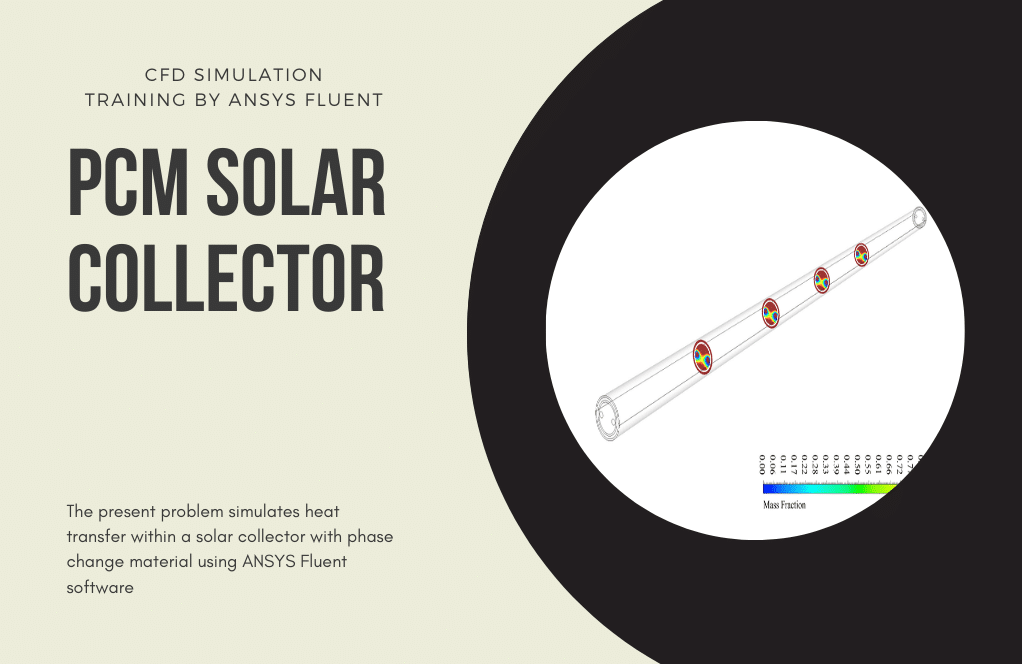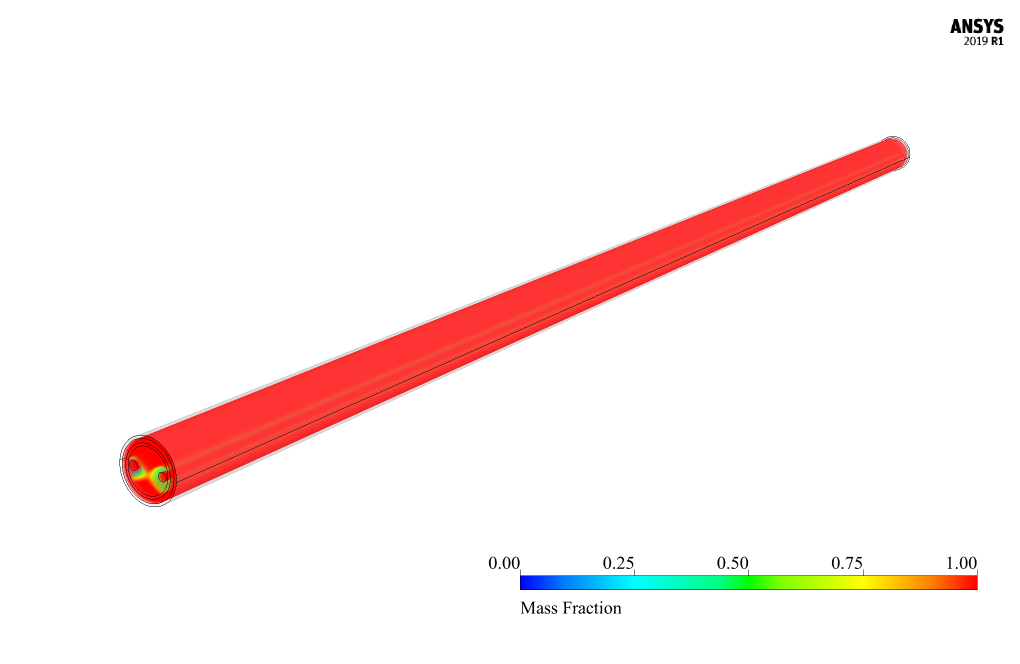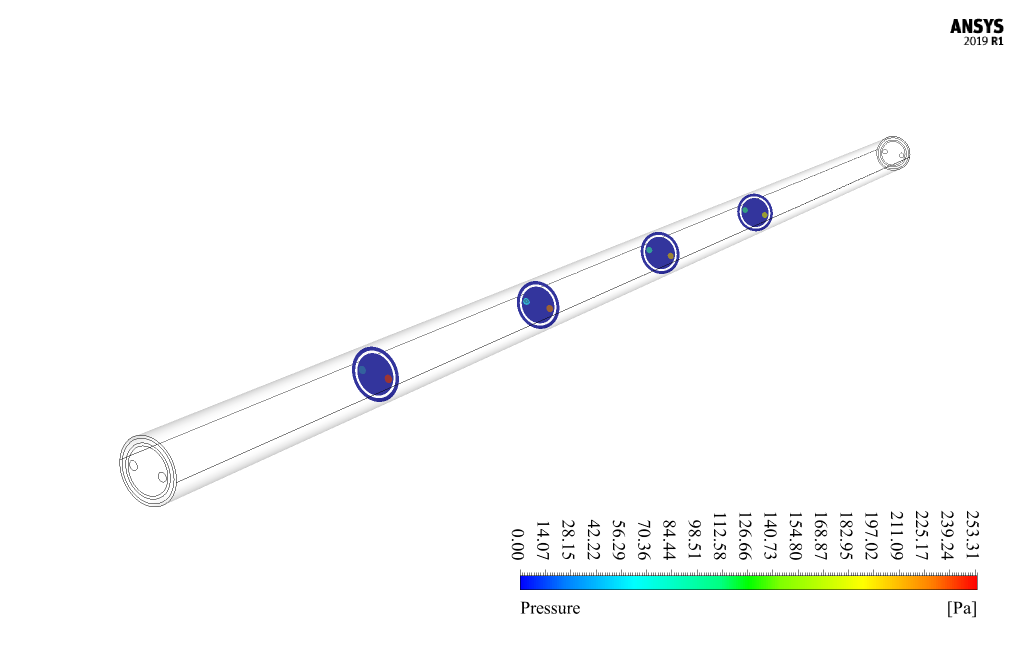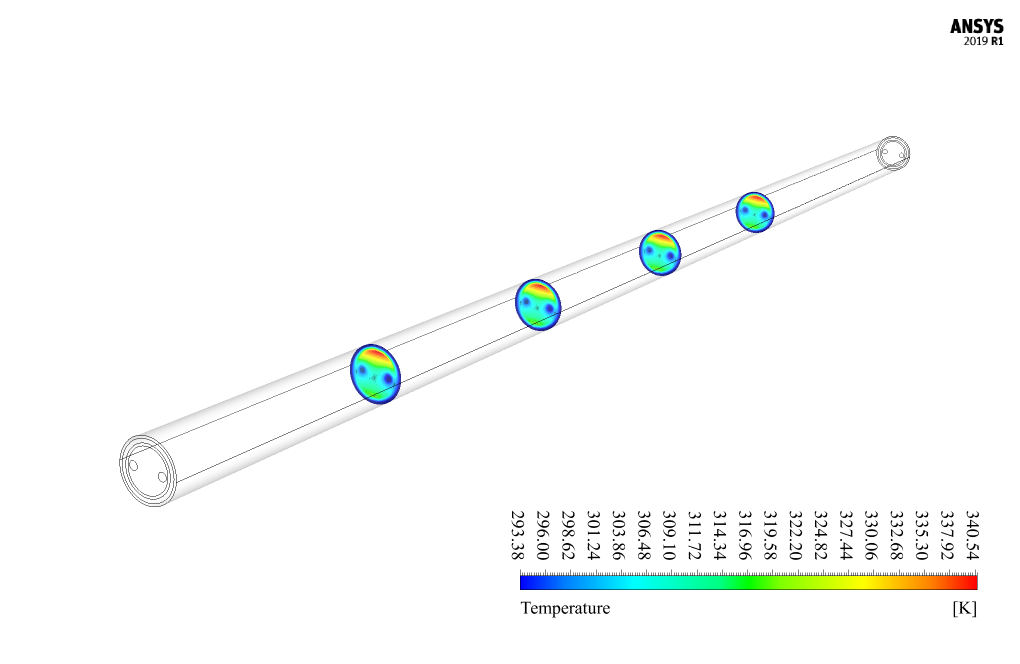PCM Solar Collector CFD Simulation by ANSYS Fluent Tutorial
$160.00 $80.00 Student Discount
- The problem numerically simulates PCM Solar Collector using ANSYS Fluent software.
- We design the 3-D model by the Design Modeler software.
- We Mesh the model by ANSYS Meshing software, and the element number equals 969866.
- We perform this simulation as unsteady (Transient).
- We use the Solidification and Melting model to define phase change materials.
- We use the Discrete Ordinate (DO) to define radiation heat transfer.
To Order Your Project or benefit from a CFD consultation, contact our experts via email (info@mr-cfd.com), online support tab, or WhatsApp at +44 7443 197273.
There are some Free Products to check our service quality.
If you want the training video in another language instead of English, ask it via info@mr-cfd.com after you buy the product.
Description
Description
The present problem simulates heat transfer within a PCM solar collector using ANSYS Fluent software. We perform this CFD project and investigate it by CFD analysis.
The current model consists of a U-shaped tube that carries water flow. Around this U-shaped tube, a cylindrical space is used, composed of phase change material (PCM).
Around this space for phase change materials, three layers are placed in a cylindrical shape. Its first layer is a solid body made of aluminum and is defined as a heat-absorbing layer caused by solar radiation. There is a layer of air gap in the next layer and then a layer of glass.
This system’s functional mechanism is that the heat caused by sunlight passes through the glass layer and heats the air layer. This heat is transferred to the absorbent layer to absorb heat in this layer.
This heat is transferred to space with phase change materials to cause a phase change in these materials. During the day, when the air is warm and there is sunlight, these materials receive the sun’s heat through the absorber layer, and part of this heat is spent on the phase change or the same process of melting in these materials.
Then, during cold weather (night), these PCMs return the latent heat stored in the environment to the surrounding environment by changing the phase, i.e., the freezing (solidification) process, thus heating the water flow inside the U-shaped tube in cold weather.
The present model is designed in two dimensions using Design Modeler software. A U-shaped pipe is two parallel pipes that carry water flow. A cylindrical layer having phase change material is located around this tube.
An aluminum absorbent tube layer in an incomplete cylinder is located around this fluid. A layer of air space in the form of an incomplete cylinder is around this aluminum tube. Finally, there is a layer of glass in an incomplete cylinder around this air space.
The meshing of the model has been done using ANSYS Meshing software, and the mesh type is structured. The element number is 969866.
PCM Solar Collector Methodology
The solidification and melting model is used in this simulation to define phase change materials. The PCM material is defined to have a density equal to 910 kg.m-3, specific heat capacity equal to 2100 j/kgK, thermal conductivity equal to 0.5 W/mK and viscosity equal to 0.0273 kg.m-1 .s-1.
Also, the maximum temperature at the solid phase temperature (solidus temperature) is 302 K. The minimum temperature at which the liquid phase is dominant (liquidus temperature) is 310 K.
The latent heat of melting of the pure solvent melting heat is defined as 178000 j/kg. The radiation model is used to define radiant heat transfer and solar radiation. The Radiation process is described as discrete ordinate or DO.
This model is used for cases where the radiation heat transfer equations are solved for a discrete number of finite solid angles. This radiation model is suitable for transparent environments, glossy screens such as mirrors, wave-dependent transmission, light scattering modes, etc.
Also, solar ray tracing mode has been activated to apply solar radiation. Then items such as longitude and latitude of the place under sunlight, date and time of radiation, solar radiation directions, direct radiation intensity, and scattering radiation intensity should be adjusted.
Moreover, the laminar model and energy equation are enabled to solve fluid equations and calculate temperature change within the domain.
PCM Solar Collector Conclusion
At the end of the solution process, three-dimensional and two-dimensional contours related to the pressure, velocity, temperature, and mass fraction of the produced liquid are obtained from the phase change material.
The images show that the PCM medium inside the central cylindrical has changed phase and, as a result, liquid has been produced in that region. It is also clear from the images that heat is transferred to the U-shaped tube when its inlet and outlet temperature are compared.

















Ms. Elfrieda Harber DVM –
Can this model simulate the performance of the solar collector with different operating conditions?
MR CFD Support –
Yes, this model can simulate the performance of the solar collector with different operating conditions by changing the boundary conditions in the simulation. This includes the flow rate of the heat transfer fluid, the initial temperature of the PCM, and the environmental conditions.
Sidney Champlin II –
I appreciate the dedication to accuracy and validation in this simulation.
Micah Spencer –
This simulation is a testament to the power of computational fluid dynamics!
Mr. Philip Hessel –
The detailed explanation in the description was really helpful and contributed to a deeper understanding of how the PCM solar collector system works. It’s great to see the use of different physical models like the solidification and melting model for PCM and the radiation model for Solar radiation.
MR CFD Support –
Thank you so much for your kind words and positive feedback! We’re thrilled to hear that our simulation of the PCM solar collector was informative and that you appreciated the comprehensive details on the application of different models to simulate the system’s behavior under solar radiation. If you have any more questions or need further information, please feel free to reach out.
Mr. Gerhard Green –
Excellent step-by-step explanation of the PCM solar collector!(No Question Here)
MR CFD Support –
Thank you for your kind words! We’re thrilled to hear that the explanation on phase change material in the solar collector simulation was clear and detailed. We aim to ensure our tutorials are comprehensive and offer insight into the theoretical and practical aspects of CFD analysis using ANSYS Fluent. Your feedback is greatly appreciated.
Chance Gutkowski –
I’m so impressed with the simulation’s level of detail, particularly the PCM phase change depiction!
MR CFD Support –
Thank you! We strive to deliver high-quality and detailed simulations. We’re glad you found the PCM solar collector simulation impressive and helpful. Your feedback is greatly appreciated!
Dr. Myrtis Barrows Jr. –
Can this model simulate the performance of the solar collector with different geometries?
MR CFD Support –
Yes, this model can simulate the performance of the solar collector with different geometries by changing the mesh in the simulation. This includes the size and shape of the collector, the thickness of the PCM layer, and the arrangement of the heat transfer tubes.
Jalen Funk MD –
This tutorial for simulating a PCM solar collector is fascinating! The step-by-step guidance on setting up the phase change materials and solar ray tracing seems very comprehensive. It’s impressive to see the level of detail in explaining how to capture the diurnal heat storage and release cycle with ANSYS Fluent.
MR CFD Support –
Thank you for your positive feedback! We are thrilled to hear that you found our tutorial on PCM solar collector simulation helpful and comprehensive. ANSYS Fluent is indeed a powerful tool for analyzing complex thermal systems, and we’re glad that you were able to appreciate the level of detail in our guide. If you have any more questions or require further assistance with your CFD projects, please feel free to reach out.
Zoila Rutherford –
The concept of the PCM solar collector tutorial is very intriguing. Could you provide details on the temperature gradient observed throughout the system, especially across the PCM during the phase change process?
MR CFD Support –
The temperature gradient across the PCM in the solar collector reveals the phase change process. You can see how the energy from the absorbed solar heat gradually causes the temperature to rise in the PCM material. As it reaches the phase change temperature, you observe a plateau in the temperature distribution where the latent heat of fusion is absorbed, causing the phase change from solid to liquid without a significant increase in temperature. We can provide specific numerics and more detailed analyses based on the conducted simulation within the tutorial itself.
Barney Torphy DVM –
Fantastic product! The PCM Solar Collector simulation tutorial was exceptionally informative. The transition from solid to liquid phase within the collector was thoroughly explained, and the investigation using CFD analysis truly illuminated the heat transfer process. I was especially impressed with the detail on the solar ray tracing mode settings which made understanding solar radiation effects so much more tangible.
MR CFD Support –
Thank you for your positive feedback! We’re delighted to hear that the tutorial met your expectations and provided a comprehensive understanding of the simulation process. Your appreciation encourages us to continue providing detailed and informative products. If you have any further questions or need assistance in future projects, feel free to reach out to us. Happy simulating!
Green Greenfelder DDS –
The explanation of the PCM Solar Collector’s functionality is fascinating! The detail on the phase change and heat absorption is especially intriguing.
MR CFD Support –
Thank you for your comments! We’re pleased to hear that you find the functionality and detailed explanation of the PCM Solar Collector simulation engaging. If you have any further questions or need more information, please feel free to reach out.
Chad Herzog –
The PCM Solar Collector simulation was incredibly detailed and educational. The step-by-step tutorial made it easier to understand the complexities involved in simulating the heat transfer process within the solar collector. Great work in explaining the use of the discrete ordinate radiation model and the solidification and melting model. The structured mesh was finely detailed, which I believe would greatly improve the accuracy of the simulation. I appreciate the clear definition of material properties and setup for solar radiation which gave a solid understanding of how to simulate real-life solar collectors using PCM.
MR CFD Support –
Thank you for your positive feedback! We’re glad that our comprehensive tutorial was helpful and you found the level of detail suitable for understanding the complexities of the PCM solar collector simulation. We ensure to provide precise material properties and boundary conditions to depict real-life scenarios accurately. Your appreciation motivates us to continue offering high-quality learning products. If you have any further insights or require assistance with other simulations, please do not hesitate to reach out. Thank you again for choosing our tutorial!
Mabel Kunze –
How does this model handle the melting and solidification of the PCM?
MR CFD Support –
This model uses the enthalpy-porosity method to simulate the melting and solidification of the PCM. This method treats the PCM as a porous medium and uses an effective heat capacity to account for the latent heat of phase change.
Cyril Haag DVM –
I am amazed at how well-described and thorough this tutorial on PCM Solar Collector CFD Simulation is. The methodology seems intricate, and it appears to cover essential phenomena such as phase change and radiation beautifully. The use of the solidification and melting model as well as the DO radiation model for solar ray tracing illustrates how in-depth the simulation goes to mimic actual conditions. Well done!
MR CFD Support –
Thank you for your kind words! We are thrilled to hear that you found the tutorial on PCM Solar Collector CFD Simulation detailed and informative. Our team works hard to provide comprehensive methodologies that help users gain a deep understanding of complex simulations. Your feedback is greatly appreciated and motivates us to continue developing quality educational content.
Lenny Upton –
This tutorial sounds impressive! I’d love to integrate PCMs in my solar projects for increased efficiency.
MR CFD Support –
Thank you for your positive feedback! We’re delighted to hear that you found our PCM Solar Collector CFD Simulation tutorial inspiring for your solar energy projects. If you ever have any questions while going through our tutorial or applying the concepts to your work, don’t hesitate to reach out to us. Happy learning and best of luck with your projects!
Antwan Rodriguez PhD –
Thank you for providing such an in-depth and comprehensive tutorial! The detailed explanation of heat transfer in the PCM solar collector and the application of phase change materials was extremely helpful. The simulation using ANSYS Fluent for predicting the performance throughout the day and night was insightful, and it really deepened my understanding of the subject.
MR CFD Support –
Thank you for your positive feedback! We’re thrilled to know that you found the tutorial comprehensive and helpful in understanding the complexities of the PCM solar collector simulation. It’s our goal to provide detailed explanations to facilitate learning and application. If you have any more interests in CFD learning materials, don’t hesitate to reach out to us!
Jewel Dibbert –
I’m thrilled with how the PCM Solar Collector simulation demonstrates the phase change process! The detailed results surely help me in understanding heat transfer and storage capacities.
MR CFD Support –
Thank you for your positive feedback. We’re pleased to know that our PCM Solar Collector simulation could enhance your understanding of the phase change process and heat transfer mechanisms. We’re committed to providing high-quality educational resources, and reviews like yours encourage us to keep improving. If you have more inquiries or need further assistance in the future, don’t hesitate to reach out to us.